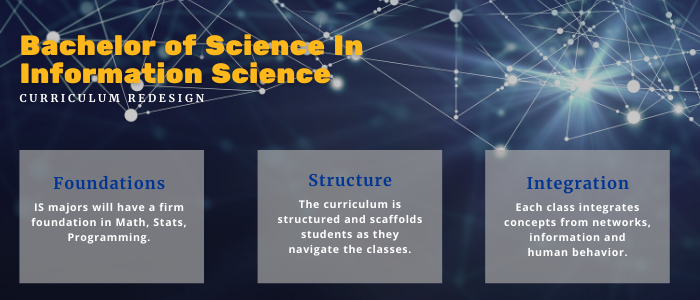
Pitt’s Department of Informatics and Networked Systems (DINS) has an illustrious 40-year history — both in terms of institutional growth and reputable curricula — and the 2020-21 academic year brings an exciting set of possibilities for undergraduate students, faculty, and staff. With a redesigned bachelor of science in information science program, the next generation of data and network specialists, information systems analysts, interface designers, and more will ascertain a wider breadth of knowledge to better prepare for an ever-changing workforce.
According to Prashant Krishnamurthy, SCI professor and chair of the Department of Informatics and Networked Systems, the nature of the School of Computing and information now being a four-year program gets students to “start thinking about degrees right from the beginning.”
"Now we have four years to spread the material out so they can gradually scaffold and build on the fundamental concepts that they have,” Krishnamurthy says.
The program has always had three interconnected pillars — data analysis, networks and security, and human-centered systems. Data analysis coursework teaches students the processes of finding and merging data in order to build models that analyze and understand data. Networks and security focuses on the connections between different entities, from data and machines to the human beings who benefit from them. The final pillar, human-centered systems, has a special home at DINS, where the faculty have expertise in human-machine interfaces, user modeling, and designing socio-technical systems. By developing an understanding of the people who actually use the data and technology, Pitt students will have a better set of capabilities for designing effective systems through the lenses of problem-solving and ease of use.
Whereas prior curriculum asked students to pursue one siloed path of study within the department, the redesign exposes students to all three early on and emphasizes the interconnectedness from one pillar to another throughout the degree. Each discipline strives to solve an aspect of a problem or task involving data generation. Take, for example, Amazon’s new smart Ring Video Doorbell, which places a camera near the house entrance to show a user who’s at their door. If you’re not home when the plumber comes, you can unlock the door from your phone to let him in. That doorbell is constantly generating data based on who comes to your door, how long they stay, and more, but how can developers allow users to benefit from the data while maintaining security and privacy?
“All of these different pieces of data in isolation may not mean much,” Krishnamurthy says. “But when you’re putting them together, you can get insights from the data and you can make better decisions that can solve problems in a more efficient manner, a sustainable manner.”
By combining the three components of the Pitt IS degree, students can solve all kinds of problems as they arise, even as the field changes. The new curriculum reflects the evolution of technology and data over the past 20 years into an increasingly omnipresent feature in regular life. In particular, our alumni have expressed their opinion on the importance of working as part of a team and having both a breadth and depth of knowledge in the field. The employers represent a variety of industries including health, education, finance, software development, and consumer products. These employers with a history of hiring Pitt grads expressed they want candidates with soft skills like adaptability and communication in addition to someone who can fill a variety of roles because of their wide-ranging skillset, which the new BSIS curriculum provides.
“We are driven more by not the immediate skills but the long-term careers of people,” Krishnamurthy says. “That’s the reason why we want everybody to have a strong foundation in what we are doing.”
